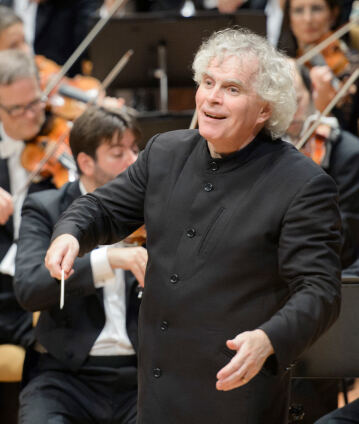Second concert in the Brahms/Schumann cycle with Simon Rattle

In this concert, Sir Simon Rattle pairs the second symphonies of Johannes Brahms and Robert Schumann. Just the juxtaposition of these works reveals much of the inner working of the two composers: On the one hand, the masterfully gripping work by Brahms, on the other, Schumann’s Second, which he wrote while suffering excruciating auditory hallucinations.
“In this work the composer reached a new high point in his oeuvre,” wrote Alfred Dörffel enthusiastically about Robert Schumann’s Second Symphony composed in 1846/47 in the Neue Zeitschrift für Musik. Ernst Gottschald even declared Schumann a worthy successor to Ludwig van Beethoven, as the C major Symphony is constructed following the example of Beethoven’s Ninth. This comparison is less far-fetched than it may appear, as Schumann’s Second follows the blueprint of consistent alignment towards the Finale, a conciliation of musical opposites ending triumphantly that characterises Beethoven’s Ninth. In contrast, Johannes Brahms’s Symphony No. 2, composed at the lake called Wörthersee in 1877, was seen by his contemporaries as being in the tradition of Beethoven’s “Pastorale”. Along those lines, for instance, Theodor Billroth, a surgeon friend of Brahms, wrote enthusiastically: “Why, it’s nothing but blue sky, the rippling brook, sunshine and cool green shade!”
Brahms on the other hand repeatedly stressed the work’s tragic sides: “The new symphony is so melancholy that you won’t be able to bear it”, he wrote in a letter to his publisher Fritz Simrock in 1877. As in his first symphony, Brahms appears here as a typical contemporary of the end of the 19th century, his view of the world no longer characterised by an undiminished optimism. In this way, moments of symphonic idyll appear as utopian (and thus fractured in a melancholy way) invocations of a long-lost peaceful and harmonic situation.
© 2014 Berlin Phil Media GmbH
Related interviews
Artists
Our recommendations
- Simon Rattle conducts Dvořák, Turnage and Brahms
- Simon Rattle conducts Stravinsky and Rachmaninov
- 2015 New Year’s Eve Concert with Simon Rattle and Anne-Sophie Mutter
- Simon Rattle conducts excerpts from Wagner’s “Götterdämmerung”
- Sir Simon Rattle conducts a Mozart Gala at the 2005 New Year’s Eve Concert
- Simon Rattle conducts Bruckner’s Ninth and Schreker’s Chamber Symphony